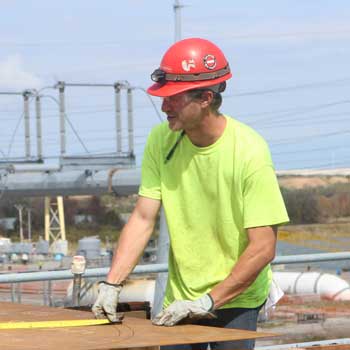When you hear the word “apprentice,” what do you think of?
Do you think of medieval times with a young blacksmith-in-training learning from a master in a castle, hammering on an anvil? Or perhaps your vision of an apprentice transports you to a galaxy far, far away full of Jedi Knights and their Padawans?
While the term apprentice often reminds us of history or fantasy, apprenticeships are still very real in modern day, and are a legitimate and important form of education and training – especially in the construction industry.
So what is a construction apprenticeship?

An apprenticeship is one of the many forms of construction craft training. In a construction apprenticeship program, apprentices learn skills and knowledge from experienced craft professionals. Examples of craft specializations that might be taught through an apprenticeship include carpentry, masonry, plumbing and welding.
Apprenticeship programs are typically hosted by individual construction companies, or through construction associations such as Associated Builders and Contractors (ABC) or The Associated General Contractors of America (AGC). Companies may have an entirely internal program, or they may partner with local association chapters or community colleges. Many companies tailor their programs to fit their current and future workforce needs.
The qualifications to become an apprentice are dependent upon the program, but in most cases minimum requirements include being at least 18 years of age with a high school diploma or GED equivalent. Some apprentices start right after high school, while others are individuals transitioning to a new career.
Although the length of these programs can vary depending on the craft and the previous experience of the apprentice, the standard apprenticeship program is about four years in duration – the same length as a four-year bachelor’s degree program. Not unlike receiving a degree, apprenticeships can also lead to industry-recognized credentials and certifications that represent their skills and knowledge progression.
While both the craft training and university routes provide career preparation, there are a few key components that make models like apprenticeships unique from other forms of postsecondary education.
The training an apprentice receives is split between classroom education and on-the-job training (OJT). Typically, apprentices spend 80% of their program in the field and the remaining 20% in the classroom.
Apprentices commonly complete their OJT work during the day with the classroom instruction being held at night. In some regions with cold winters where construction work is limited by weather, the indoors learning might be more heavily scheduled during the snow season.
With this hybrid system, trainees have a valuable and relevant educational experience where they learn theories and concepts and are immediately able to apply and practice them in a hands-on way.
Another iconic feature of craft training and apprenticeships is the ability to “earn while you learn.” Apprentices and trainees receive wages for their on-the-job work, which increase incrementally as they progress through their training. This means that they are getting paid to be educated!
Because of the high demand for craft professionals and construction skills, many companies invest in their apprentices and take on any additional costs associated with the education, and will often directly hire apprentices to full-time positions upon completion of the program.
With topics like student debt – estimated at more than $1.5 trillion total in the United States – and underemployment of recent graduates surrounding the university education model, apprenticeships provide a refreshing option that allow students and trainees to earn money while accruing no education debt and having almost guaranteed job placement in a high-paying industry.

There are two types of apprenticeship programs: Registered apprenticeship programs (RAPs), or nonregistered programs, also known as industry-recognized apprenticeship programs (IRAPs).
RAPs have been validated either federally by the U.S. Department of Labor or locally by a state agency, and meet specific standards set by those agencies. IRAPs are not registered with a government agency and are not tied to the government requirements. Being registered offers some perks to programs such as access to government resources, while nonregistered programs can have more flexibility in their curricula to meet the needs of the organization. Many IRAPs are accredited with non-government organizations such as NCCER, which has curricula designed to meet DOL standards regardless.
No matter their status, both registered and industry-recognized apprenticeship programs offer quality training, credentials and career opportunities.
The apprenticeship model of education has been around for centuries, dating back to the Middle Ages, and there’s a reason this system has persisted and remains relevant. Many of today’s electricians, pipefitters, roofers and other construction professionals have learned their craft through an apprenticeship. And with skilled positions in high demand, construction apprenticeships are more important now than ever.
Interested in becoming an apprentice? Click here to learn how to find an apprenticeship near you.